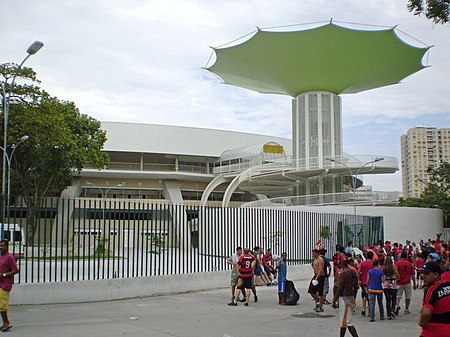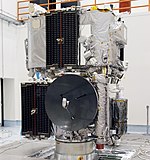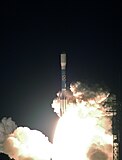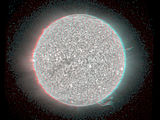STEREO
| |||||||||||||||||||||||||||||||||||||||||||||||||||||||||||||||||||||||
Read other articles:

Low-budget movie theater that shows mainly exploitation films For the film, see Grindhouse (film). This article needs additional citations for verification. Please help improve this article by adding citations to reliable sources. Unsourced material may be challenged and removed.Find sources: Grindhouse вҖ“ news В· newspapers В· books В· scholar В· JSTOR (November 2014) (Learn how and when to remove this message) 42nd Street in 1985 Times Square, showing the Ly…

Artikel ini perlu dikembangkan dari artikel terkait di Wikipedia bahasa Inggris. (April 2024) klik [tampil] untuk melihat petunjuk sebelum menerjemahkan. Lihat versi terjemahan mesin dari artikel bahasa Inggris. Terjemahan mesin Google adalah titik awal yang berguna untuk terjemahan, tapi penerjemah harus merevisi kesalahan yang diperlukan dan meyakinkan bahwa hasil terjemahan tersebut akurat, bukan hanya salin-tempel teks hasil terjemahan mesin ke dalam Wikipedia bahasa Indonesia. Jangan m…

American computer security expert This article uses bare URLs, which are uninformative and vulnerable to link rot. Please consider converting them to full citations to ensure the article remains verifiable and maintains a consistent citation style. Several templates and tools are available to assist in formatting, such as reFill (documentation) and Citation bot (documentation). (August 2022) (Learn how and when to remove this message) Howard SchmidtCyber Security Coordinator of the Obama Adminis…

Comics character Silver SorceressImage of the character Silver Sorceress from Justice League Europe #35 (February 1992), art by Darick Robertson.Publication informationPublisherDC ComicsFirst appearanceJustice League of America #87 (February 1971)Created byMike FriedrichDick DillinIn-story informationAlter egoLaura Cynthia NeilsenTeam affiliationsJustice League EuropeChampions of AngorJustice LeagueJustice League InternationalAbilitiesMagical abilities The Silver Sorceress is a DC Comics charact…

Questa voce sugli argomenti arene di pallacanestro e palazzetti di pallavolo ГЁ solo un abbozzo. Contribuisci a migliorarla secondo le convenzioni di Wikipedia. GinГЎsio do MaracanГЈzinhoMaracanГЈzinho, GinГЎsio Gilberto Cardoso Informazioni generaliStato Brasile UbicazioneRua Professor Rabelo20271-111 Rio de Janeiro Inizio lavori24 settembre 1954 Inaugurazione1954 Chiusuraottobre 2003 Ristrutturazione2003-2007 Costi di ricostr.R$ 97 000 000 ProprietarioSoprintendenza delle s…

Tonsur di RomaTonsur adalah praktik pemotongan rambut bagi para klerus Katolik sebagai tanda penerimaan golongan mereka pada ordo-ordo tertentu sesuai panggilan masing-masing untuk mengabdi kepada Allah dan gereja.[1] Pada upacara ini para uskup memotong sedikit rambut sebagai lambang meninggalkan dunia profan atau keduniawian.[1] Di beberapa negara, upacara ini dilakukan dengan cara para imam tetap memotong rambut sampai pada ubun-ubun sebesar lingkaran 2 cm atau semuanya.&…

M4A2 dan M4A3 dialihkan ke halaman ini. Untuk persenjataan, lihat Bushmaster M4 Type Carbine. Tank Medium M4 Sebuah model M4 (105) Sherman dipajang di Langenberg Liberation Memorial, Ede, Belanda. Jenis Tank kelas medium Negara asal Amerika Serikat Sejarah pemakaian Masa penggunaan 1942вҖ“55 (Amerika Serikat) 1945вҖ“2018 (Negara lain) Digunakan oleh Amerika Serikat, dan negara-negara lain (lihat Varian dan pengguna di negara lain) Pada perang Perang Dunia II, Perang Sau…

Vonzell SolomonInformasi latar belakangNama lahirVonzell Monique SolomonLahir18 Maret 1984 (umur 40)Baxley, GeorgiaAsalFort Myers, Florida, Amerika SerikatGenrePop, R&BPekerjaanPenyanyi, aktrisInstrumenVokalTahun aktif2004вҖ“sekatangLabelVonzell, atau Baby V Entertainment, dulunya dikenal sebagai Melodic Records (CEO) Vonzell Monique Solomon (lahir 18 Maret 1984), berjuluk Baby V, adalah seorang penyanyi dan aktris asal Amerika Serikat yang meraih peringkat ketiga dalam musim keempat da…

РЈ СҚСӮРҫРіРҫ СӮРҫРҝРҫРҪРёРјР° РөСҒСӮСҢ Рё РҙСҖСғРіРёРө Р·РҪР°СҮРөРҪРёСҸ, СҒРј. РҜСҒРҪР°СҸ РҹРҫР»СҸРҪР°. РҹРҫСҒёлРҫРәРҜСҒРҪР°СҸ РҹРҫР»СҸРҪР° 52В°27вҖІ19вҖі СҒ. СҲ. 36В°57вҖІ34вҖі РІ. Рҙ.HGРҜO РЎСӮСҖР°РҪР° Р РҫСҒСҒРёСҸ РЎСғРұСҠРөРәСӮ РӨРөРҙРөСҖР°СҶРёРё РһСҖР»РҫРІСҒРәР°СҸ РҫРұлаСҒСӮСҢ РңСғРҪРёСҶРёРҝалСҢРҪСӢР№ СҖайРҫРҪ РҹРҫРәСҖРҫРІСҒРәРёР№ РЎРөР»СҢСҒРәРҫРө РҝРҫСҒРөР»РөРҪРёРө РҳРІР°РҪРҫРІСҒРәРҫРө РҳСҒСӮРҫСҖРёСҸ Рё РіРөРҫРіСҖафиСҸ Р’СӢСҒРҫСӮР° СҶРөРҪСӮСҖР° 223 Рј …

Nauplia redirects here. For other uses, see Nauplius. Municipality in GreeceNafplio ОқОұПҚПҖО»О№ОҝMunicipalityClockwise from top right: Palamidi Fortress, Acronauplia Clock Tower, Nafplio Old Town, Constitution Square, Bourtzi Castle, Othonos Street, Nafplio Town Hall. Bottom of the photo of the central square of Nafplio: View of Nafplio and the surrounding areas.NafplioLocation within the region Coordinates: 37В°33вҖІ57вҖіN 22В°48вҖІ00вҖіE / 37.56583В°N 22.80000В°E / 37.…

РЎРөСҖРіРөМҒР№ Р’РҫР№СҶРөС…РҫМҒРІСҒРәРёР№ РІ С„РҫСҖРјРө РіРөРҪРөСҖала Р°СҖРјРёРё Р§РөС…РҫСҒР»РҫРІР°СҶРәРҫР№ СҖРөСҒРҝСғРұлиРәРё. 1938 РҡР°СӮРөСҖРёРҪР° РЎРёРҪСҸРәРҫРІР° ДмиСӮСҖРёР№ РҜСҲРәРёРҪ Р СғСҒСҒРәРёРө РІ Р§РөС…РёРё вҖ” РҝРҫ РҙР°РҪРҪСӢРј Р§РөСҲСҒРәРҫРіРҫ РЎСӮР°СӮРёСҒСӮРёСҮРөСҒРәРҫРіРҫ РҰРөРҪСӮСҖР° (ДҢSГҡ), СҮРөСӮРІС‘СҖСӮРҫРө РҝРҫ СҮРёСҒР»РөРҪРҪРҫСҒСӮРё РҪР°СҶРёРҫРҪалСҢРҪРҫРө РјРөРҪСҢСҲРёРҪСҒСӮРІРҫ, РҫРәРҫР»Рҫ 33 СӮСӢСҒСҸСҮ СҮРөР»РҫРІРөРә РҪР° РәРҫРҪРөСҶ 2013 РіРҫРҙР°[1]…

Bilateral relationsColombian - British relations United Kingdom Colombia Diplomatic missionEmbassy of Colombia, LondonBritish Embassy, ColombiaEnvoyAmbassador NГ©stor Osorio LondoГұoAmbassador Colin Martin-Reynolds vteAnglo-Spanish wars 1585вҖ“1604 1625вҖ“1630 1654вҖ“1660 1662вҖ“1668 1702вҖ“1713 1718вҖ“1720 1727вҖ“1729 1739вҖ“1748 1762вҖ“1763 1779вҖ“1783 1796вҖ“1802 1804вҖ“1808 1815вҖ“1832 1833вҖ“1840 ColombiaвҖ“United Kingdom relations are the bilateral and diplomatic relations between Colombia…

American politician & attorney (born 1937) Judy BiggertMember of the U.S. House of Representativesfrom Illinois's 13th districtIn officeJanuary 3, 1999 вҖ“ January 3, 2013Preceded byHarris FawellSucceeded byBill Foster (Redistricting)Member of the Illinois House of Representativesfrom the 81st districtIn officeJanuary 1993 вҖ“ January 1999Preceded byThomas McCrackenSucceeded byPatti Bellock Personal detailsBornJudith Gail Borg (1937-08-15) August 15,…

Proverbs 17вҶҗ chapter 16chapter 18 вҶ’The whole Book of Proverbs in the Leningrad Codex (1008 C.E.) from an old fascimile edition.BookBook of ProverbsCategoryKetuvimChristian Bible partOld TestamentOrder in the Christian part21 Proverbs 17 is the seventeenth chapter of the Book of Proverbs in the Hebrew Bible or the Old Testament of the Christian Bible.[1][2] The book is a compilation of several wisdom literature collections, with the heading in 1:1 may be intended to …

German politician (1919вҖ“2008) Annemarie RengerAnnemarie Renger in 1973President of the Bundestag West GermanyIn office13 December 1972 вҖ“ 14 December 1976Preceded byKai-Uwe von HasselSucceeded byKarl CarstensVice President of the Bundestag(on proposal of the SPD-group)In office1976вҖ“1990Preceded byHermann Schmidt-VockenhausenSucceeded byHelmut Becker Personal detailsBorn(1919-10-07)7 October 1919Leipzig, GermanyDied3 March 2008(2008-03-03) (aged 88)Remagen, GermanyPolitical par…

Private, all-female school in Anaheim, , California, United StatesCornelia Connelly SchoolAddress2323 West BroadwayAnaheim, (Orange County), California 92804United StatesCoordinates33В°49вҖІ46вҖіN 117В°57вҖІ51вҖіW / 33.82944В°N 117.96417В°W / 33.82944; -117.96417InformationTypePrivate, All-FemaleMottoLead, Serve, InspireReligious affiliation(s)Roman Catholic[1]Patron saint(s)Cornelia ConnellyEstablished1961FounderSisters of the Society of the Holy Child JesusClose…

Questa voce sull'argomento cantanti statunitensi ГЁ solo un abbozzo. Contribuisci a migliorarla secondo le convenzioni di Wikipedia. Segui i suggerimenti del progetto di riferimento. Kelly Price NazionalitГ Stati Uniti GenereRhythm and bluesSoul Periodo di attivitГ musicale1992 вҖ“ in attivitГ Sito ufficiale Modifica dati su Wikidata В· Manuale Kelly Price (New York, 4 aprile 1973) ГЁ una cantante statunitense di genere R&B/soul. Price ГЁ nata a Queens, N…

66 radio telescopes in the Atacama Desert of northern Chile Atacama Large Millimeter ArrayAlternative namesAtacama Large Millimeter and Submillimeter Array Part ofEvent Horizon TelescopeLlano de Chajnantor Observatory Location(s)Atacama Desert, Antofagasta Region, Atacama Desert, Chile Coordinates23В°01вҖІ09вҖіS 67В°45вҖІ12вҖіW / 23.0193В°S 67.7532В°W / -23.0193; -67.7532 OrganizationEuropean Southern ObservatoryNational Institutes of Natural Sciences, JapanNati…

This article needs additional citations for verification. Please help improve this article by adding citations to reliable sources. Unsourced material may be challenged and removed.Find sources: Frank and Gordon вҖ“ news В· newspapers В· books В· scholar В· JSTOR (August 2022) (Learn how and when to remove this message)Fictional character Frank and GordonAdvertisement featuring the characters from 2008.First appearance2005Last appearance2008In-universe informat…

第дёүеҚҒдёҖеұҠеӨҸеӯЈеҘ§жһ—еҢ№е…ӢйҒӢеӢ•жңғеҲ’иҲ№еҘіеӯҗе…«дәәе–®ж§іжҜ”иіҪжҜ”иіҪе ҙйӨЁзҫ…еҫ·йҮҢжҲҲВ·еј—йӣ·еЎ”ж–ҜжҪҹж№–ж—Ҙжңҹ8жңҲ8ж—ҘиҮі13ж—ҘеҸӮиөӣйҖүжүӢ56дҪҚйҒёжүӢпјҢдҫҶиҮӘ7еҖӢеңӢ家е’Ңең°еҚҖеҶ еҶӣжҲҗз»©6:01.49еҘ–зүҢиҺ·еҫ—иҖ…01 ! еҹғзұіиҺүВ·йҮҢз”ҳйҳҝжӣјиҫҫВ·жіўе°”е…ӢеҮҜзү№зҗіВ·ж–ҜеҘҲеҫ·е…ӢдёҪВ·иҘҝи’ҷе…№еҠідјҰВ·ж–Ҫжў…зү№жһ—зү№иҺҺВ·жҲҲеҚҡжў…ж №В·й©¬ж–Ҝе°јеҹәеҹғе°”В·жҙӣж №йҳҝжӣјиҫҫВ·еҹғе°”иҺ«е°” зҫҺеӣҪ02 ! еҮҜи’ӮВ·ж јйӣ·еӨ«ж–Ҝжў…жӢүеҰ®В·еЁҒе°”йҖҠеј—жң—иҘҝдёқВ·йңҚйЎҝжіўиҺүВ·ж–Ҝж—әжқ°иҢңе…













